건축 미술의 일종인 단청(丹靑)은 목조 건축물의 보존을 위해 오래전부터 활용되었으며, 불교의 수용과 함께 더욱 발전해 오늘에 이르고 있다. 박근덕(Park Geun-deok, 朴根德)은 20년째 문화재 복원 사업에 참여하고 있는 단청 전문가이다. 동시에 전통 단청에서 얻은 모티프를 자신만의 시선으로 해석해 보여 주는 창작 단청 작가로도 활동 중이다.
Dancheong, the traditional Korean art of decorating buildings with intricate patterns, has been used since ancient times to preserve wooden structures. It began to flourish with the introduction of Buddhism in the 4th century and continues to this day. Artist and dancheong artisan Park Geun-deuk has been involved in cultural heritage restoration for 20 years and reinterprets the traditional art’s motifs and designs in her own original style
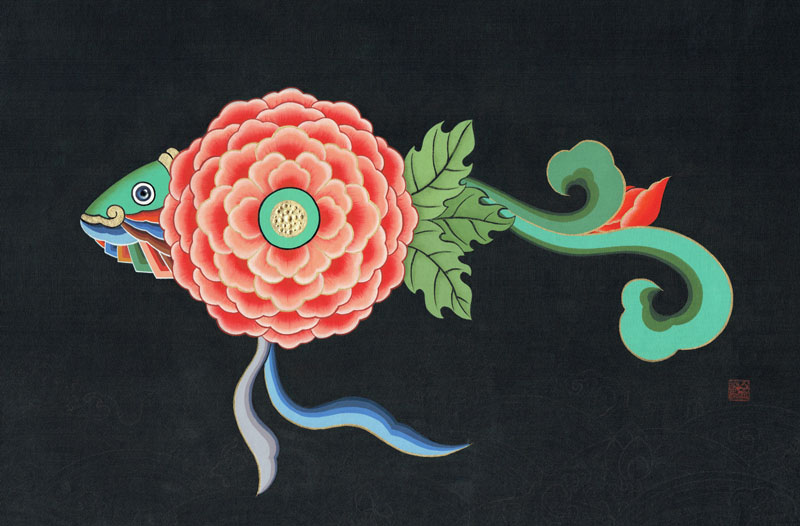
한국의 궁궐과 사찰에서는 꽃 피는 계절이 아니어도 화려함을 느낄 수 있다. 다채로운 문양과 빛깔로 건물을 아름답게 꾸민 단청 덕분이다. 본래 단청은 기후 변화에 취약한 목조 건축물을 더위와 추위, 습기 등으로부터 보호해 내구성을 강화하기 위한 목적에서 출발했다. 나아가 문양의 사용과 채색 방식을 통해 왕실의 권위나 종교적 신성함을 나타내는 역할도 한다.
The splendor of Korean palaces and Buddhist temples is owed to the vibrant colors and patterns of dancheong. This form of decorative painting was originally used to protect wooden structures vulnerable to changing weather conditions, improving their durability by shielding them from heat, cold, moisture, and more. It was also used to denote architectural hierarchy with different color schemes representing the authority of royal power, religious sanctity, and other values.
“단청은 건물이 입고 있는 옷이라고 할 수 있어요. 왕과 신하의 의복이 구별되는 것처럼 단청도 건물의 용도와 중요성에 따라 문양과 색을 달리합니다.” As dancheong artist Park Geun-deuk explains, “Dancheong is likened to clothing for buildings. Just as the attire of kings and courtiers differs, so does the ornamental coloring according to the building’s purpose and significance.”
박근덕 씨의 설명이다. 불교의 영향을 받은 단청은 우리나라뿐 아니라 불교 문화권인 몽골, 일본, 중국, 티베트에서도 볼 수 있다. 하지만 양식은 나라마다 다르다. 일본은 붉은색 위주의 채색이 특징이고, 중국은 청색과 녹색을 주로 사용한다. 그에 비해 한국 단청은 음양오행 사상에 따라 청(靑), 적(赤), 백(白), 흑(黑), 황(黃)의 오방색(五方色, 동서남북과 중앙의 다섯 방위를 상징하는 색)을 보색 대비로 채색하되 난색과 한색을 교차해 밝고 어두운 명도 차이를 줌으로써 화려함을 극대화한다.
Reflecting the influence of Buddhism, dancheong can be seen in Korea and other countries with Buddhist heritage, including China, Japan, and Mongolia. The style varies from country to country; in Japan it is mainly red, and in China predominantly blue and green. In Korea, on the other hand, buildings are adorned with obangsaek, the Colors of Five Directions — blue, red, white, black, and yellow — representing east, west, south, north, and center, respectively. This is based on the theory of eumyangohaeng, yin and yang and the five elements of metal, wood, fire, water, and earth. The paint emphasizes the contrast between complementary colors, alternating between warm and cool or bright and dark tones, which helps maximize vibrancy.
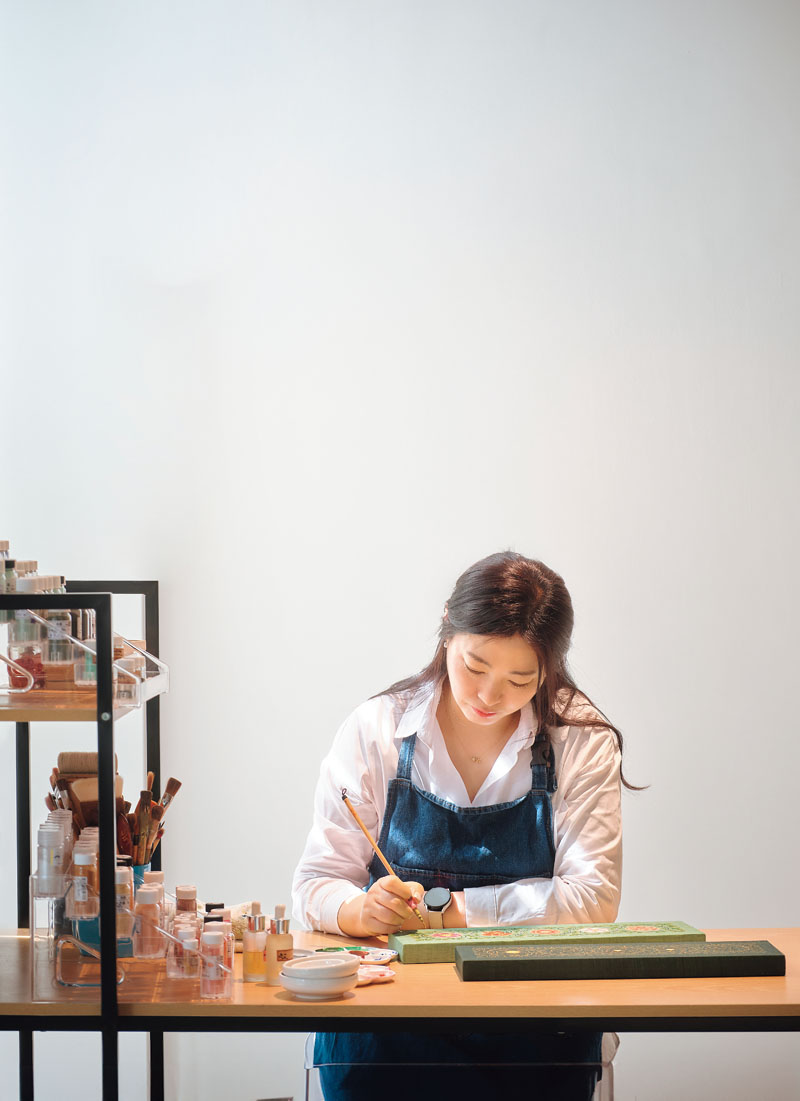
문양과 색의 조합 – COMBINING PATTERNS AND COLORS
단청 작업은 채색이 잘되도록 하기 위해 아교(阿膠, 전통 접착제)를 바르는 데서 시작한다. 이를 위해 먼저 단청할 부재(部材)의 틈새나 구멍을 메우고 사포질로 정리한 다음 아교를 2회 이상 바른다. 그다음에는 뇌록(磊綠)이나 석간주(石間硃) 같은 천연 안료로 밑칠을 한다. 종이에 밑그림을 그리고 문양의 외곽선을 따라 촛바늘(草針)로 일정 간격으로 구멍을 낸 다음, 단청할 부재 면에 도안을 대고 조갯가루를 담은 분 주머니로 선을 따라 두드려 문양이 나타나도록 한다. 단청할 색을 만들어 도안대로 채색한 다음 조갯가루를 털어내고 들기름칠을 해서 마무리한다.
The painting process begins with ensuring an even surface. Any gaps or holes in the wood are filled and smoothed with sandpaper, and then agyo, traditional cow hide glue, is applied two or more times. Next comes a base coat of natural pigment, such as celadonite or red ocher. A design is drawn on paper and the patterns’ outlines are pierced with a needle at regular intervals. Then, the paper is placed on the surface of the wood to be painted and tapped with a bag filled with shell powder along the punched lines to copy the patterns on the wood’s surface. Once the colors are prepared, they are applied according to the design. Finally, the shell powder is brushed off and linseed oil is applied for finishing.
단청은 크게 네 가지로 분류한다. 우선 아무런 문양을 넣지 않고, 색도 한 가지만 칠하는 방식이 있다. 이는 가장 낮은 등급의 단청 양식으로, 위계가 낮은 건축물이나 일반 주택에 사용한다. 그러나 조선(1392~1910) 시대 역대 왕과 왕비의 위패를 모신 종묘처럼 최고 품계의 전각에도 이러한 방법이 시공되는 경우가 있다. 공간의 엄숙함을 표현하기 위해서다. 두 번째로 바탕색을 칠한 다음 그 위에 선을 긋는 방식이 있다. 주로 사당 같은 부속 건물에 적용하는데, 선을 넣는 것만으로도 격식이 갖춰지는 효과가 있다.
Dancheong can be broadly divided into four styles of increasing complexity. The simplest involves only a single base color without any patterns. This is used for public buildings of lesser importance and private homes, but also for palace buildings of the highest rank to express their solemnity. A notable example is Jongmyo, the royal ancestral shrine of the Joseon Dynasty (1392–1910). The second style consists of a single base color and some lines drawn along the borders. It is used to decorate subsidiary buildings, such as ancestral shrines in temples and Confucian institutions, in order to an atmosphere of formality.
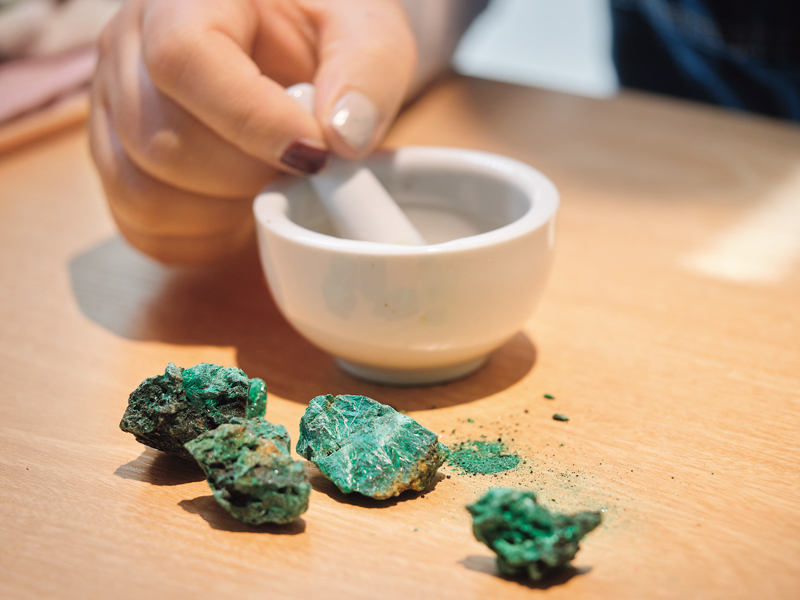
또한 보나 도리 같은 부재의 양쪽 끝에만 문양을 그리고, 중심부는 채색만 하는 경우도 있다. 사찰의 부속 건물을 비롯해 궁궐 전각이나 서원, 정자 등 일반적인 건축 단청에 두루 사용되는 형식이다. 이렇게 부재의 끝부분에만 넣는 무늬를 ‘머리초(草)’라고 하는데, 건물 품계에 따라 머리초가 화려해지기도 하고 간소해지기도 한다.
The third style features patterns drawn at both ends of buildings’ supporting beams, leaving the middle with only a base color. This style is widely used for different types of architecture, such as the auxiliary buildings of temples, palace halls, Confucian academy lecture halls, and pavilions. The patterns used in this style are called meoricho, beam-end patterns, whose complexity depends on the building’s prominence.
마지막으로 부재의 모든 부분에 빼곡하게 문양을 넣어 화려함을 극대화하는 방법이 있다. 대웅전 같은 사찰 주요 건축물에 활용하는 최고 등급의 양식이다. The final and most elaborate style, used mostly for the main halls of Buddhist temples, involves covering the entire surface of the wood with intricate patterns to maximize splendor.
“조선왕조실록에 보면 유생들이 ‘사가(私家)에서 단청을 못 하게 해달라’고 상소를 올린 기록이 있습니다. 그만큼 단청은 사치스러운 것으로 여겨져 궁궐에서조차 최고 등급의 단청은 하지 않았죠. 유교의 영향이기도 하지만, 예나 지금이나 단청 원료가 비싼 원석들인 탓도 있죠.”
“Annals of the Joseon Dynasty, a vast collection of records of state affairs, has an entry that mentions Confucian scholars petitioning to ban the use of ornamental painting for private homes. Dancheong was considered so luxurious that even royal palaces weren’t decorated in the most elaborate style. This was partly due to the influence of Confucianism, which emphasized modesty, but also because the raw materials for painting were, and still are, very expensive minerals,” Park explains.
단청 문양도 여러 갈래로 나누어진다. 가장 빈번하게 사용되는 것은 연화(蓮花)머리초다. 연꽃, 석류, 녹화(綠花, 녹색으로 그린 꽃무늬) 등의 조합으로 이뤄진 연화머리초는 사찰과 궁궐뿐 아니라 향교, 서원 같은 유교 건축물의 단청에서도 쉽게 볼 수 있다.
The most common dancheong pattern is yeonhwa meoricho, the beam-end lotus pattern, which incorporates the motifs of a lotus blossom, pomegranate, and green flowers. It is often found on subsidiary buildings in Buddhist temples and royal palaces, Confucian educational institutions, such as hyanggyo (public schools) and seowon (private academies), and other common structures, such as pavilions.
“저도 연화머리초를 많이 응용해서 그립니다. 기본에 충실하게 그리기도 하지만 때로는 중심에 위치하는 연꽃 대신 민들레, 고마리 같은 토종 들꽃을 문양으로 만들어서 그리기도 해요.”
“I also use this pattern a lot in my work,” Park says. “Sometimes I paint it in the traditional style, and sometimes I modify it a bit by replacing the lotus blossom at the center with motifs of local wildflowers, such as Korean dandelion and Thunberg’s smartweed.”
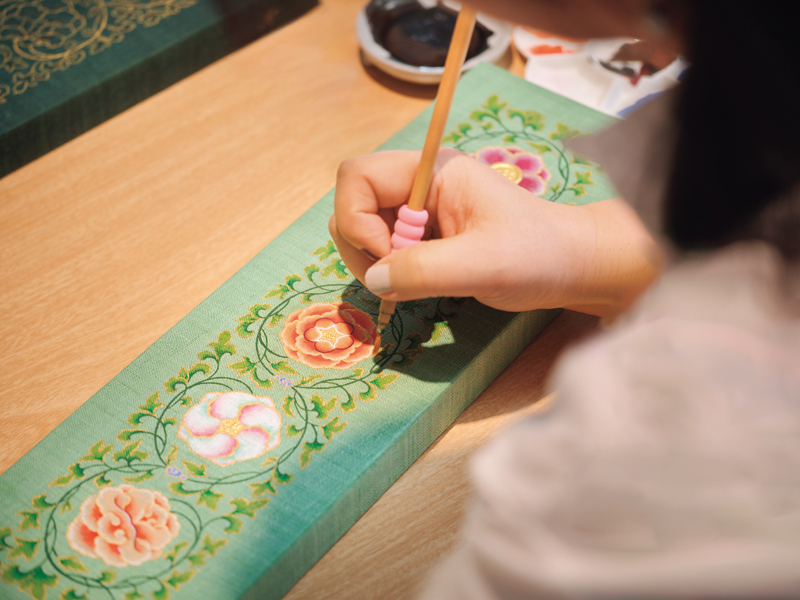
새로운 시도 – CREATIVE APPLICATIONS OF TRADITION
박근덕 씨는 2022년 갤러리 이즈(Galley IS)에서 개최한 첫 개인전 < Goldgarden > 이후 매년 전시회를 통해 전통 단청을 새롭게 형상화한 창작 단청으로 호평받고 있다. 지난해 갤러리 한옥(Gallery HANOK)이 주관한 불화∙민화 공모전에서 최우수상을 수상했고, 이어서 무우수갤러리(MOOWOOSOO GALLERY, 無憂樹) 초대전 <알로록달로록 철없는 코끼리>에서는 동식물을 모티브로 한 작품으로 주목받았다.
Park held her first solo exhibition, Goldgarden, at GALLERY IS in 2022. Since then, she has been praised for her original dancheong reinterpretations, which she has presented in annual exhibitions. Last year, she won the grand prize at the Buddhist and Folk Paintings Contest hosted by Gallery Hanok, and was recognized for her paintings of flora and fauna motifs at the invitational exhibition During the Colorful: The Innocent Elephant, held at Moo Woo Soo Gallery.
이 전시에서는 연꽃과 민들레로 머리 장식을 한 코끼리를 비롯해 선사 시대 유물인 울주 대곡리 반구대 암각화(Petroglyphs of Bangudae Terrace in Daegok-ri, Ulju)에 그려진 고래가 단청으로 소환된 작품들을 볼 수 있었다. 그런가 하면 불꽃 대신 물결무늬 날개를 단 봉황, 멸종위기종인 자생 식물 문양을 입은 물고기, 비단 위에 단아한 자태로 누운 제주 토종 무와 당근 등이 단청을 입고 색다른 존재감을 드러냈다.
At the invitational, Park displayed dancheong-inspired works depicting, for instance, an elephant adorned with a headpiece in the shape of lotus and dandelion flowers, and a whale similar to those in the prehistoric Bangudae Petroglyphs in Daegok-ri, a village in Ulsan. Her other paintings were equally striking: phoenixes with wings expressed with ocean waves instead of flames, fish decorated with endangered indigenous plants, as well as radishes and carrots native to Jeju Island exquisitely depicted on silk fabric.
“전통 단청에는 연꽃, 모란과 같이 상징성이 있는 꽃들이 문양으로 많이 쓰이는데, 제 개인 작업을 할 때는 좋아하는 꽃이나 주변에서 흔히 볼 수 있는 들풀을 문양으로 만들어 봅니다. 그리고 전통 단청에서는 각종 문양들이 서로 엮여 있는데, 저는 이 문양들을 하나씩 풀어낸 뒤 제가 표현하고 싶은 형태로 다시 엮어 봅니다. 이런 시도가 재미있어요.”
“Traditionally, the most popular dancheong motifs are lotuses, peonies, and other flowers with symbolic meanings. However, when working on my personal projects, I designs based on my favorite flowers or wild grasses commonly found in nature. Traditional patterns have a number of interconnected motifs, but I tend to unravel and combine them in my own way. I find these experiments quite enjoyable,” Park says.
그녀는 한 치의 오차도 허용하지 않는 엄격한 문화재 복원 작업에서 오는 갑갑함을 자신만의 세계를 담은 작품을 통해 해소한다고 말한다. The artist also describes how working on her original paintings gives her a sense of freedom, especially when she feels constrained by the rigorous nature of cultural heritage restoration work, with no margin for error.
“문화재가 위치한 장소들은 대개 주변 풍광이 좋아요. 작업 현장에서 벗어나 주변 자연 속을 거닐다 보면 마음이 편안해져요. 풀 한 포기, 돌 하나에도 눈길이 가고 작은 꽃잎 하나도 허투루 보이지 않죠. 한참을 들여다보면 각각의 세계가 눈에 들어와요. 그 순간의 이미지를 문양으로 만들어 보자는 생각으로 작업을 하게 됐죠.
“Cultural heritage sites are usually located in scenic places. Taking a walk in the natural surroundings away from the work site is truly relaxing. My eyes are drawn to everything; even a blade of grass, stones, or tiny flower petals are never missed. When I look at them closely, I realize that each of the natural s contains a world of its own. I started working on my personal projects to use the images of these moments in my original patterns.”
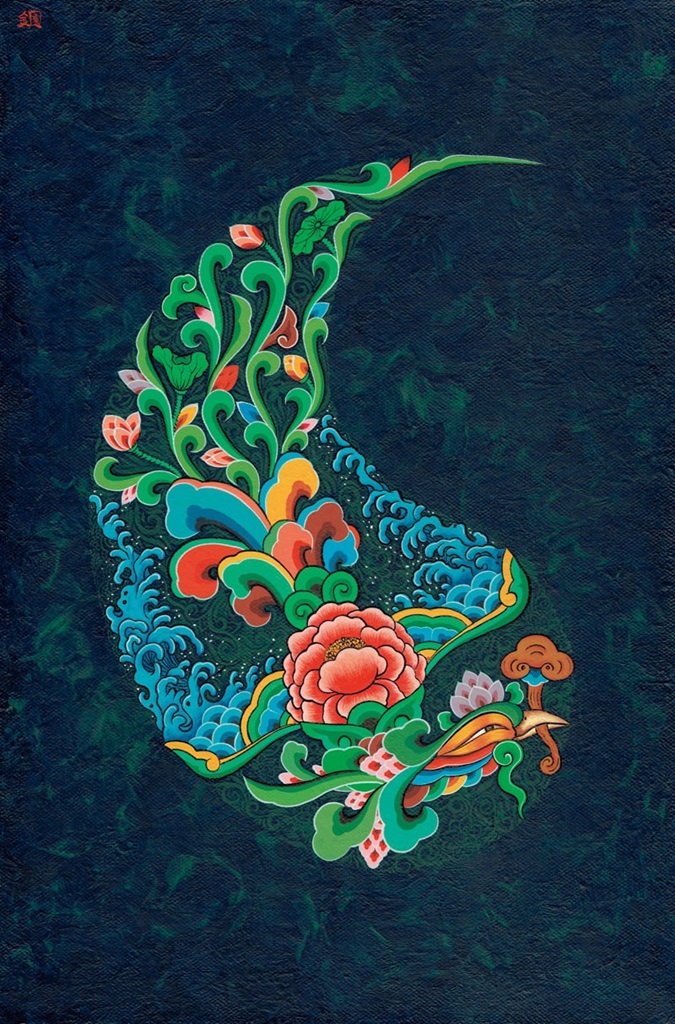
창작의 원천 – SOURCE OF INSPIRATION
문화재수리기술자인 그녀는 대부분 남성들로 구성된 작업 현장을 진두지휘한다. 문화재수리기술자의 역할이 문화재수리기능자들의 작업을 지도하고 감독하는 것이기 때문이다.
박근덕 씨는 1999년 동국대학교 미술학부에 입학해 불교 미술을 전공했다. 졸업과 동시에 문화재 복원 현장에서 일을 시작했으며 틈틈이 공부해 자격증을 따고 2022년부터 단청 감리를 해오고 있다.
As a cultural heritage repair engineer, Park directs and supervises the work sites of cultural heritage repair technicians, who are predominantly male. In 1999, she enrolled at Dongguk University to study Buddhist art. Immediately after graduating, she began working in cultural heritage restoration, and since acquiring her license in 2022, has also supervised dancheong painting at various sites.
“드센 공사판에서 바닥부터 일을 배웠지만 한계가 있었죠. 그래서 대학원에 다니며 단청기술자 자격증을 땄어요. 대부분 도제식으로 일을 익힌 작업자들은 대학 전공자를 그리 달가워하지 않아요. 첫 대면에 ‘누구 밑에 있었냐’, ‘스승이 누구냐’부터 물으니까요. 어느 스승의 초(草), 즉 밑그림을 받아서 수련했는지에 따라 유파가 갈리거든요. 그래서 힘든 시기도 있었지만, 지금은 네트워크가 발달해 여러 현장을 다니면서 다양한 기술과 기법을 배울 수 있습니다.”
“I learned the basics of my work from scratch at the actual work sites, but I felt my knowledge was limited. So, I went to graduate school and obtained a qualification as a dancheong artisan. Most artisans who have learned the craft through apprenticeship are reluctant to accept college graduates. When they meet a newcomer, they start by asking, ‘Who did you work for?’ or ‘Which master did you study under?’ Depending on which master’s cho [patterns] you used for your training, you automatically belong to a certain school. I used to find this suffocating at times, but I now have a wide network that allows me to learn various techniques and skills while working at many different sites,” Park explains.
문화재 복원은 주로 관급 공사다 보니 철저히 설계도 안에서 작업이 이뤄진다. 간혹 작업 중에 설계 단계에서 놓친 하자가 발생하기도 하는데, 이때 보수부터 재설계 여부까지 발주처와 현장 사이를 조율하는 것도 그녀의 주요 역할이다.
Since most heritage restoration projects are government commissions, all procedures are carried out by strictly adhering to design plans. Occasionally, when an error in the design is found at the restoration site, one of Park’s main responsibilities is coordinating between the client and the site to revise or re the design.
“안료와 접착제를 섞는 비율만 해도 회화나 금박 작업에는 교과서와 같은 매뉴얼이 있어요. 하지만 단청은 건축물의 위치나 기후 등 여러 가지 조건을 고려해야 하기 때문에 폭넓은 경험이 중요합니다.” 단청은 회화는 물론 서예, 드로잉, 공예까지 아우르는 종합적인 기량이 필요하다. 그가 특별히 단청에 끌린 이유다.
“When it comes to preparing colors, for example, there are textbook-like manuals for other genres such as painting and gilding, right down to the proportion of pigments and glue. However, dancheong relies more on extensive experience, as a wide range of conditions like the location of the building and the climate must be taken into account.” As Park expounds, dancheong requires a comprehensive skill set that includes painting, calligraphy, drawing, and handicrafts. This is what attracted her most to the art.
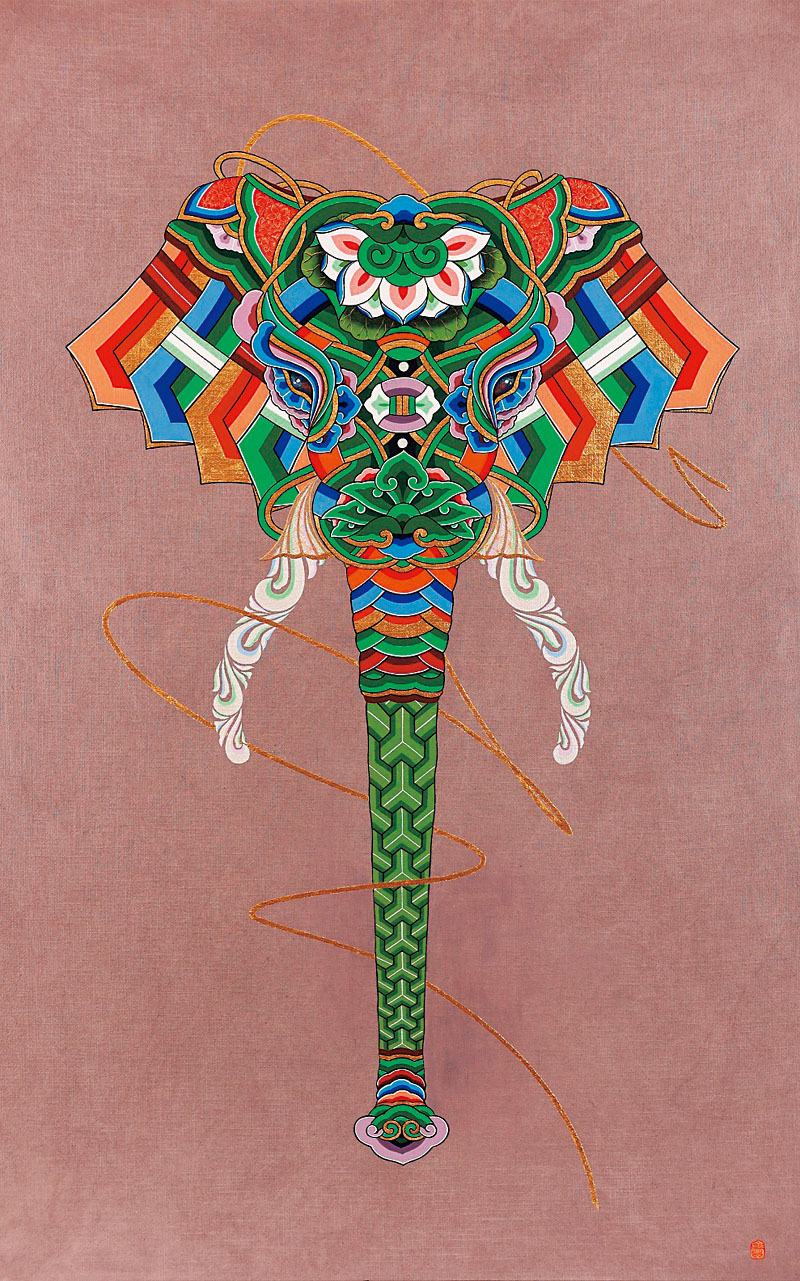
“단청기술자는 탱화도 보수해야 합니다. 불교 미술에는 탱화도 있지만 산수화도 있어요. 산스크리트어가 들어간 그림도 있고, 호랑이가 등장하는 산신도도 있죠. 그래서 단청기술자는 글씨와 탱화, 화조도, 수묵화 모두 공부해야 합니다.”
“The job of a dancheong artisan includes repairing Buddhist murals that are often found at temples. These murals are mostly paintings of sacred scenes, but they also feature landscapes, Sanskrit words, mountain gods with tigers, and other imagery. Therefore, the artisan should have a broad knowledge of Buddhist art, including calligraphy, religious murals, flower and bird paintings, ink wash paintings, and so on.”
그녀는 오래된 건축물에 남겨진 옛사람들의 붓 터치를 보면 전율이 온다고 말한다. 이런 일을 할 수 있어서 정말 행복하다고 느낄 정도다. 그 행복감이 바로 창작의 원천이다.
Park is thrilled whenever she looks at the brushstrokes left on old buildings by people from the past. Her work brings her genuine happiness, which is, in turn, the source of her inspiration and creativity.
이기숙(Lee Gi-sook, 李基淑)작가
이민희 포토그래퍼
Lee Gi-sook Writer
Lee Min-hee Photographer
